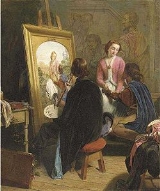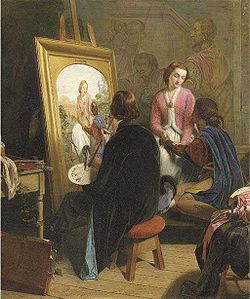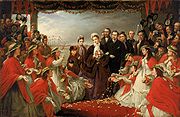
Henry Nelson O'Neil
Encyclopedia

Indian Rebellion of 1857
The Indian Rebellion of 1857 began as a mutiny of sepoys of the British East India Company's army on 10 May 1857, in the town of Meerut, and soon escalated into other mutinies and civilian rebellions largely in the upper Gangetic plain and central India, with the major hostilities confined to...
. Eastward, Ho!, dated August 1857 but exhibited the following year, depicts the British
United Kingdom
The United Kingdom of Great Britain and Northern IrelandIn the United Kingdom and Dependencies, other languages have been officially recognised as legitimate autochthonous languages under the European Charter for Regional or Minority Languages...
troops embarking for India. A second painting, Home Again, (1859) shows the troops returning to England. He also had popular successes with romantic scenes portraying the deaths of Mozart and Raphael
Raphael
Raffaello Sanzio da Urbino , better known simply as Raphael, was an Italian painter and architect of the High Renaissance. His work is admired for its clarity of form and ease of composition and for its visual achievement of the Neoplatonic ideal of human grandeur...
, depicted as though mentally transported to heaven by their own religious art. In The Last Moments of Mozart the dying composer listens to singers performing part of his Requiem
Requiem
A Requiem or Requiem Mass, also known as Mass for the dead or Mass of the dead , is a Mass celebrated for the repose of the soul or souls of one or more deceased persons, using a particular form of the Roman Missal...
. The Last Moments of Raphael shows the painter contemplating the unseen figure of Christ in his Transfiguration
Transfiguration (Raphael)
The Transfiguration is considered the last painting by the Italian High Renaissance master Raphael. It was left unfinished by Raphael, and is believed to have been completed by his pupil, Giulio Romano, shortly after Raphael's death in 1520...
.

The Clique
The Clique was a group of English artists formed by Richard Dadd in the late 1830s. Other members were Augustus Egg, Alfred Elmore, William Powell Frith, Henry Nelson O'Neil, John Phillip and Edward Matthew Ward....
, a group of artists in the 1840s who, like the later Pre-Raphaelite Brotherhood
Pre-Raphaelite Brotherhood
The Pre-Raphaelite Brotherhood was a group of English painters, poets, and critics, founded in 1848 by William Holman Hunt, John Everett Millais and Dante Gabriel Rossetti...
, met regularly to discuss and criticize one another's works. The other members of The Clique were Augustus Egg
Augustus Egg
Augustus Leopold Egg 2 May 1816 in London, England – 26 March 1863) was a Victorian artist best known for his modern triptych Past and Present , which depicts the breakup of a middle-class Victorian family.-Biography:...
, Alfred Elmore
Alfred Elmore
Alfred Elmore was a Victorian history and genre painter. He was born in Cork, Ireland, the son of Dr. John Richard Elmore, a surgeon who retired from the British Army to Clonakilty....
, Richard Dadd
Richard Dadd
Richard Dadd was an English painter of the Victorian era, noted for his depictions of fairies and other supernatural subjects, Orientalist scenes, and enigmatic genre scenes, rendered with obsessively minuscule detail...
, William Powell Frith
William Powell Frith
William Powell Frith , was an English painter specialising in genre subjects and panoramic narrative works of life in the Victorian era. He was elected to the Royal Academy in 1852...
, John Phillip
John Phillip
John Phillip was a Victorian era painter best known for his portrayals of Spanish life. He was nicknamed "Spanish Phillip"....
, Edward Matthew Ward
Edward Matthew Ward
Edward Matthew Ward was an English Victorian narrative painter best known for his murals in the Palace of Westminster depicting episodes in British history from the English Civil War to the Glorious Revolution.-Early career:...
.
Most of the Clique opposed the Pre-Raphaelites, but O'Neil was the most virulent in his condemnation of the movement, attacking them in both paintings and writings. These included his futuristic fantasy 2000 Years Hence, which portrayed Britain in the year 3967 as a frozen wasteland excavated by an archaeologist from New Zealand
New Zealand
New Zealand is an island country in the south-western Pacific Ocean comprising two main landmasses and numerous smaller islands. The country is situated some east of Australia across the Tasman Sea, and roughly south of the Pacific island nations of New Caledonia, Fiji, and Tonga...
. The archaeologist uncovers evidence of the decline of British culture in the nineteenth century, allowing O'Neil to vent his own distinctly reactionary
Reactionary
The term reactionary refers to viewpoints that seek to return to a previous state in a society. The term is meant to describe one end of a political spectrum whose opposite pole is "radical". While it has not been generally considered a term of praise it has been adopted as a self-description by...
political views, predicting dire consequences of the Reform Act 1867
Reform Act 1867
The Representation of the People Act 1867, 30 & 31 Vict. c. 102 was a piece of British legislation that enfranchised the urban male working class in England and Wales....
.

